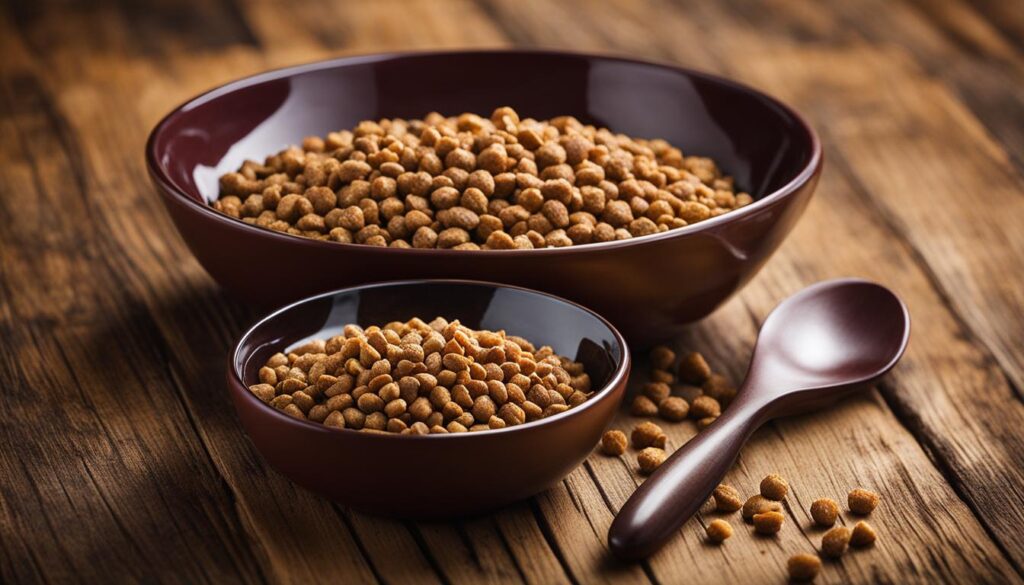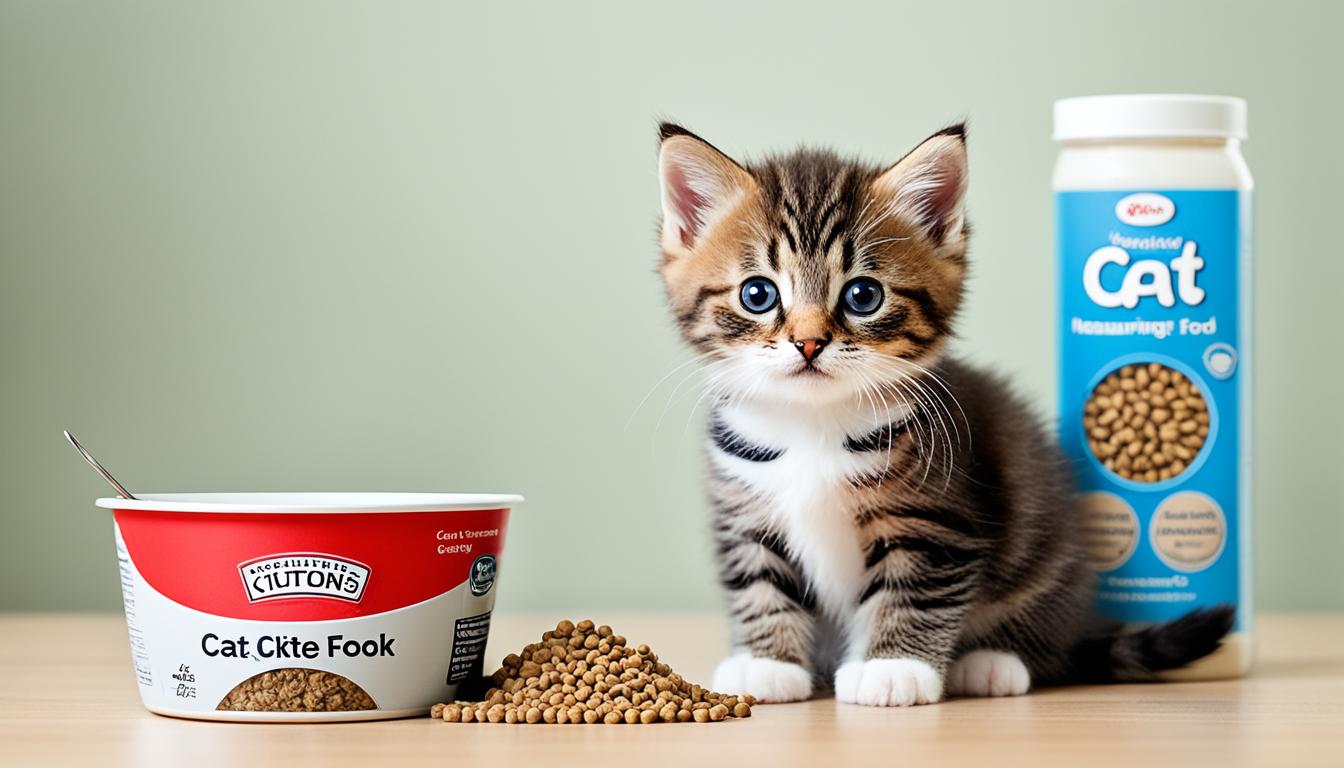As an Amazon Associate I earn from qualifying purchases.
Picture this: you bring home a tiny ball of fur, full of curiosity and mischief, and you instantly fall in love. Whether you’re a seasoned cat parent or embarking on the journey for the first time, one question lingers in your mind: how much should I feed my adorable little kitten?
Feeding a kitten is a crucial part of their development, and providing them with the right nutrition sets them up for a healthy life ahead. But with so much conflicting information out there, it can be overwhelming to navigate the world of kitten feeding.
Well, fret not, because we’re here to guide you through it all. From understanding their dietary requirements to choosing the best kitten food, we’ve got you covered. So get ready to embark on a purrfect adventure of understanding how to nourish your furry friend!
Key Takeaways:
- Feeding kittens a nutritionally complete and age-appropriate diet is essential for their growth and development.
- Kittens require higher levels of protein, calories, and certain nutrients compared to adult cats.
- You have the choice of feeding wet or dry cat food, each with its advantages and disadvantages.
- Choosing a high-quality kitten food with balanced nutrition and minimal filler ingredients is key.
- Start with the recommended feeding guidelines on the food packaging and consult with your veterinarian for personalized advice.
What to Feed Kittens
Feeding your kitten a proper diet is essential for their growth and development. It’s important to provide them with the right nutrients to support their energy needs and ensure they have the building blocks for healthy muscles, bones, and organs. Here are some nutrition tips to help you determine what to feed your kittens:
Animal-Based Protein
Protein plays a crucial role in your kitten’s development, as it supports healthy growth and provides energy. Ensure that their diet includes higher proportions of animal-based protein which is easily digestible and contains essential amino acids.
Calcium and Phosphorus
These minerals are vital for your kitten’s bone growth and development. Make sure their diet includes increased amounts of calcium and phosphorus to promote strong bones and teeth.
Commercial Kitten Food
Feeding your kitten a balanced commercial kitten food is recommended as it is formulated to meet their specific nutritional needs. Look for a reputable brand that uses high-quality ingredients and has undergone rigorous testing to ensure safety and nutritional adequacy.
Avoid Fillers
Avoid feeding your kittens food that contains a lot of filler ingredients. These fillers provide little nutritional value and may lead to digestive issues or nutrient deficiencies. Read the ingredient labels carefully and choose a food that prioritizes high-quality ingredients.
By following these nutrition tips, you can ensure that your kittens receive the proper diet they need to thrive. Remember to consult with your veterinarian for specific feeding recommendations based on your kitten’s age, weight, and overall health.
In the next section, we will compare the pros and cons of wet and dry cat food to help you make an informed decision about the best feeding option for your kittens.
| Pros | Cons |
|---|---|
| High moisture content | May stick to teeth |
| Supports hydration | Potential for dental problems |
| Contains essential nutrients | Shorter shelf life |
| Can be more palatable | May require refrigeration |
Wet Vs. Dry Food
Kittens have different dietary requirements than adult cats, and choosing the right food for them is essential for their overall health and well-being. When it comes to feeding your kitten, you have two main options: wet cat food and dry cat food. Both options have their pros and cons, so it’s important to consider your kitten’s specific needs and consult with your veterinarian before making a decision.
Pros and Cons of Wet Cat Food
Wet cat food, as the name suggests, has a higher moisture content compared to dry cat food. This can be beneficial for kittens as it helps keep them hydrated. The extra moisture in wet cat food can also support their urinary tract and kidney health. Additionally, many kittens find wet cat food more palatable, making it easier for them to eat and enjoy their meals.
However, there are a few downsides to wet cat food. One concern is that it can stick to kittens’ teeth, potentially leading to dental problems. Regular dental care, such as brushing teeth or providing dental treats, can help mitigate this issue. Another consideration is that wet cat food tends to spoil quickly once opened, so it may require more frequent feeding and careful storage.
Pros and Cons of Dry Cat Food
Dry cat food, on the other hand, offers its own set of advantages. It is convenient, especially for multi-cat households, as it can be left out without spoiling quickly. Dry cat food is also beneficial for dental health, as the crunchiness helps to remove plaque and tartar build-up. Additionally, it tends to be more cost-effective than wet cat food, making it a popular choice for many cat owners.
However, there are some considerations when it comes to feeding kittens dry cat food. One potential downside is that some kittens may overeat and gain excessive weight if they have unlimited access to dry food. This can lead to various health issues, such as obesity and related conditions. It’s crucial to monitor your kitten’s portion sizes and ensure they are maintaining a healthy weight.
Ultimately, the choice between wet and dry cat food will depend on your kitten’s specific needs and your preferences as a cat owner. It’s important to consider the pros and cons of each option and consult with your veterinarian for personalized advice. They can help you determine the best diet plan for your kitten to ensure they receive the right nutrition for optimal growth and development.
| Wet Cat Food | Dry Cat Food |
|---|---|
| Higher moisture content | Convenient and easy to feed |
| Helps keep kittens hydrated | Aids in tartar control |
| Supports urinary tract and kidney health | Cost-effective |
| May stick to teeth and cause dental problems | Potential for overeating and weight gain |

Selecting High-Quality Kitten Food
When it comes to providing the best nutrition for your furry friend, choosing high-quality kitten food is crucial. Not all cat foods are created equal, and it’s essential to feed your kitten a diet that supports their growth and overall health.
So, how do you go about selecting the right kitten food? Start by comparing different brands and options available in the market. Look for a diet that contains high-quality protein sources, as protein is a vital component for your kitten’s development. Opt for foods that list real meat as the primary protein source, such as chicken, turkey, or fish.
Avoid foods that are packed with filler ingredients, such as grains or by-products. Fillers provide little nutritional value and can even lead to digestive issues in kittens. Reading the ingredient list and avoiding foods that contain artificial preservatives, flavors, and colors is also essential.
Why Protein Source Matters
Kittens require a higher amount of protein in their diet compared to adult cats. Protein helps support their rapidly growing bodies, providing the necessary amino acids for muscle development, organ function, and overall vitality.
Did you know? Kittens are obligate carnivores, which means they require a meat-based diet to meet their nutritional needs.
Choosing a kitten food with a high-quality protein source ensures that your little one gets the essential nutrients they need to thrive. It’s always a good idea to consult with your veterinarian to determine which food is best suited for your kitten’s specific needs. They can provide expert guidance based on your kitten’s age, breed, and overall health.
Comparing Kitten Food Brands
When comparing kitten food brands, it’s helpful to consider the nutritional value, ingredient quality, and reputation of the manufacturer. Look for brands that prioritize the overall health and well-being of kittens, using natural ingredients and avoiding unnecessary additives.
One way to assess the quality of a kitten food brand is to check if they meet established industry standards, such as the Association of American Feed Control Officials (AAFCO) guidelines. AAFCO sets nutritional standards for pet foods, ensuring that they meet the minimum requirements for essential nutrients.
Remember, your kitten’s diet plays a significant role in their long-term health and development. Investing in high-quality kitten food now can set the foundation for a lifetime of well-being.
Here’s a comparison table of some popular kitten food brands:
| Brand | Protein Source | Filler Ingredients | Artificial Additives |
|---|---|---|---|
| Brand A | Real chicken, turkey, and fish | No | No |
| Brand B | Chicken meal and by-products | Yes | Yes |
| Brand C | Salmon and rice | No | No |
Remember, this is just a small sample of brands, and it’s important to do further research and consult with your veterinarian before making a final decision on which kitten food to choose. Your kitten’s specific needs may vary, and it’s important to find the best option that fits their requirements.

By selecting high-quality kitten food, you are setting your furry friend up for a healthy and happy life. The right nutrition makes a world of difference, supporting their growth, energy levels, and overall well-being. Don’t compromise on your kitten’s health – choose high-quality kitten food today!
How Much to Feed a Kitten
Kittens require more food compared to adult cats due to their rapid growth. Feeding guidelines may vary for different brands and formulas, but a good starting point is to follow the recommended feeding directions on the food packaging. These guidelines typically provide information on the proper kitten meal amounts based on their age and weight.
It’s important to adjust the amount of food as needed based on your kitten’s individual requirements. Factors such as their current weight, growth rate, and activity level should be considered in determining the appropriate portion sizes.
Your veterinarian can be a valuable resource in calculating the caloric requirements for your kitten. They can assess your kitten’s specific needs and help you determine the right amount of food to feed them. Monitoring your kitten’s weight and body condition regularly will ensure they are growing at a healthy rate and receiving adequate nutrition.
“Feeding guidelines provide a valuable starting point, but it’s crucial to tailor your kitten’s meals to their individual needs.”
Example Feeding Guidelines
Here’s an example of a feeding guideline for kittens based on their age:
| Age | Number of Meals per Day | Amount per Meal |
|---|---|---|
| 4-8 weeks | 4-6 | 1/4-1/3 cup (divided into meals) |
| 8-16 weeks | 3-4 | 1/3-1/2 cup (divided into meals) |
| 16-25 weeks | 3 | 1/2 cup (divided into meals) |
| 25+ weeks | 2 | 1/2-3/4 cup (divided into meals) |
Note: These guidelines are just a starting point and may vary depending on the specific food brand and your kitten’s individual needs. It’s always best to consult with your veterinarian for personalized feeding recommendations.
Properly feeding your kitten is crucial for setting them up for a healthy and happy life. By following appropriate feeding guidelines, monitoring their weight and growth, and consulting with your veterinarian, you can ensure your kitten receives the right amount of nutrition to thrive.
Healthy Kitten Growth Rate
Watching your kitten grow is an exciting part of being a cat parent. During their first year, kittens experience rapid growth and development. Understanding their growth rate and weight milestones can help you ensure they are thriving.
Kittens typically gain about 1 pound per month during their first year. This means that at 1 month old, they weigh about 1 pound, and at 2 months old, they weigh about 2 pounds, and so on. Their growth rate is impressive, and you’ll be amazed at how quickly they reach each milestone.
Most of their growth occurs within the first year, and their growth plates close around one year old. This means that their bones stop growing longer, and they have reached their adult size. Around this time, your veterinarian will usually transition your kitten to an adult diet tailored to meet their nutritional needs.
It’s important to note that each kitten is unique, and variations in growth rate can occur. Genetics, breed, and overall health can influence how fast or slow a kitten grows. Regular check-ups with your veterinarian will help ensure your kitten’s growth is on track and that any potential issues are addressed.
By monitoring your kitten’s weight and growth rate, you can ensure that they are growing at a healthy pace and provide them with the proper care they need at each stage of their development.
Conclusion
Feeding kittens the right amount of nutritious food is essential for their growth and development. You want to choose a high-quality kitten food that meets their specific nutritional needs. Consulting with your veterinarian is crucial in determining the appropriate portion sizes and feeding schedule for your kitten. This will help ensure they are receiving the proper amount of calories to support their growth.
Monitoring your kitten’s weight and body condition is also important in ensuring they are growing at a healthy rate. Keep an eye on their overall appearance and consult with your veterinarian if you have any concerns. By providing the right nutrition and care, you can help your kitten grow into a healthy and happy adult cat.
To summarize the feeding guidelines for kittens, remember to:
- Choose a high-quality kitten food that meets their specific nutritional needs
- Consult with your veterinarian to determine the appropriate portion sizes and feeding schedule
- Monitor your kitten’s weight and body condition to ensure they are growing at a healthy rate
By following these guidelines, you can ensure that your kitten gets the best start in life and grows into a thriving adult cat.
FAQ
How much should I feed a kitten?
What should I feed my kitten?
Should I feed my kitten wet or dry food?
How do I choose high-quality kitten food?
How much should I feed my kitten?
What is a healthy growth rate for kittens?
How can I ensure my kitten grows up healthy?
Source Links
- https://www.petmd.com/cat/nutrition/feeding-kittens-101-what-feed-how-much-and-how-often
- https://www.smalldoorvet.com/learning-center/nutrition/cat-kitten-nutrition-101/
- https://straycatalliance.org/resources/kittens101/feeding-kittens/
As an Amazon Associate I earn from qualifying purchases.

